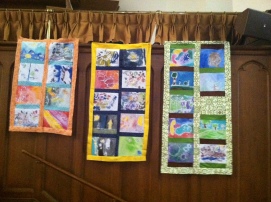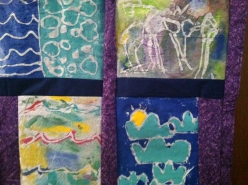Earlier this month I co-preached with an eight-year old from my congregation. As is often the case I processed this experience in a sermon, which was preached at the Community Mennonite Church (Harrisonburg, VA) retreat on Oct 18.
1 Corinthians 1:18-31
Every year our church participates in Children’s Sabbath, a worship service dreamed up by the people at The Children’s Defense Fund. Communities of worship from around the country invite children to take on the whole of the service – reading Scripture, ushering, displaying art, and leading in prayer.
While the church I serve participates in Children’s Sabbath there is always one part of worship that remains firmly in the hands of adults. That is preaching. But this year I wanted to try it out, to give a child in our congregation access to the pulpit.
I chose Hannah. She’s naturally curious, inquisitive. She loves church and she’s not afraid to look silly. All of these I believe are traits of a good preacher. I remember one Sunday after Hannah read Scripture she turned to her mother and said, “I have been waiting my whole life to get up there.” So it sounded like she would be up for it.
Because I am brave or foolish, or because the line between the two is very thin, I also decided to continue to follow the lectionary. The passages for the next four weeks were all from the book of Job. Many of you probably know this story, about God making this strange wager with Satan and then letting Satan destroy Job’s life. Satan kills off his family, destroys his home, wrecks his business. Everything is taken from him. Nothing is left of his life, except his own body. And then God allows Satan to decimate this as well, to cover Job with sores from head to toe.
Hannah and I read this story aloud to one another, paragraph by paragraph of oozing sores, piles of trash, heaps of ashes. After we were done she turned to me and said, “I don’t think this story is appropriate for children.”
We went for it anyway. We wrote a sermon together. And what Hannah said was that God doesn’t do a great job of being God in this story. God acts like a person, she told me. It’s Job who acts like God, the way we want God to be for us. It’s Job who never gives up, who stays faithful, who sits in the depths of his pain – literally in ashes – but does not stray from the path of love. God, the one up in the clouds, peers down, unaware, it seems, of Job’s life. This God is erratic, easily tricked, led away from faithfulness. Hannah told me that we want a God like Job.
I have to admit, I was a little nervous about this reading. The reason is that I’m an adult. These honest questions, these devastating questions about God’s behavior, that’s a kind of thing that makes me uncomfortable. I felt like we needed to clear up those questions, come to some conclusion. But there wasn’t one.
I came to preach like an adult. Hannah came to play like a child. In the expanse of her imagination, unbridled by a sense of the right questions, unaware that there were places we shouldn’t push the congregation, or that certain thoughts were off limits – away from all of this, Hannah played with the Scriptures. She played with our ideas about retribution and grace, about who God is and what God should or shouldn’t be doing. She imagined outside the prohibitions we place on these texts.
One of the reasons I put Job in the hands of Hannah is that I wanted to follow her into that play. My role as her co-preacher was to amplify her voice, to help adults hear the things that she was trying to say. Sometimes that was uncomfortable. I had to fight back against my own sense of preservation of order, of keeping things in line.
The more time I spend with children like Hannah the less surprised I am at the number of times Jesus calls them forth as exemplars of faith. Before I started spending time with children I thought this had something to do with innocence or blind faith. What I think now is that Jesus saw that children know how to play. And they know how to fail.
Today I’m thinking of failure as a kind of foolishness, the kind that Paul lauds to the people of Corinth, this crop of diverse people who have gathered together around the teachings of Jesus. The Corinthians wrestle with what it means to live out this foolishness. Paul opens his letter to them with this exhortation about being fools. He tells them that this kind of foolishness is inscribed into the cross. “For since,” he says, “in the wisdom of God, the world did not know God through wisdom, God decided, through the foolishness of our proclamation, to save those who believe.”
This letter reflects Paul’s desire to dissolve social hierarchies, to see those with wealth and privilege giving up their social standing as they live out the beloved community of Jesus. This will require them to fail. They will fail the social expectations of their Greco-Roman neighbors. They’ll look like fools, giving up the parties, the places of political influence, that serve meat sacrificed to idols. The Corinthians are being asked to create a new world. But it will come with embarrassment.
The world Paul shows them, the world that Jesus created, is bound for failure. We know this because the church is still unable to live out the peaceable kingdom described by Paul over 2000 years later. We don’t have it within us. And yet we keep trying to find a way, we keep trying out these unbelievable dreams, these beautiful, impossible worlds. We keep doing that and we keep failing at it. Over and over again.
Yesterday we looked at the ways play makes room to imagine these new worlds. We looked at graffiti—the way graffiti opens up communities of resistance. We looked at the play of protest and how humor holds power up to ridicule, how it refuses to take seriously the way things have always been done.
And today we’re following children into foolishness, into what the forms of power in our world call foolishness. Because children deliver us from the orderliness and predictability that blocks our view of the world into which Jesus invites us, the kinds of reforming that the Corinthians resisted.
Each year my church has three interns from Duke Divinity school who are learning to be pastors or teachers or social workers. For a year they work alongside our ministry team. Each new intern season I think of a way to let our children welcome them.
This year, thanks to the power of social media, I came across the idea of a sticker blessing. I’d seen pictures of my friend Megan being welcomed as the pastor of Seattle Mennonite by children placing stickers on her. I thought, this is perfect for us. We would mark our interns as ours, for this season.
When the time came in the service for our sticker blessing I invited the three young men down to the front and had them sit on the kneeler of the prayer rail, their heads just below the level of our children. Each of the children got three stickers, one per intern, whom they would mark as our own.
I had somewhat underestimated the number of children, almost thirty, and how much stickering would take place. Stickers were everywhere – covering our interns mouths and eyes, children laughing and reaching in to get closer. It was bordering on chaos, an unruliness we invited.
Later, when we debriefed this experience we discussed the discomfort of this action. Putting stickers on our interns, sitting so low to the ground, blurred the lines between children and adults. It was vulnerable – these adults were put into the hands of children, put into their world. There was something chaotic about this moment, like we’d lost control.
Jack Halberstam names the character of childhood that fills it with both promise but apprehension for adults. She explains that, “children are not coupled, they are not romantic, they do not have a religious morality, they are not afraid of death or failure, they are collective creatures, they are in a constant state of rebellion against their parents, and they are not the masters of their domain. Children stumble, bumble, fail, fall, hurt; they are mired in difference, not in control of their bodies, not in charge of their lives, and they live according to schedules not of their own making.”[1] Children introduce us to the foolishness of being fully outside the status quo.
At the same time children show us how to try and try again, how to create a world only to have it swept away, renegotiated or destroyed by forces outside their control, and then to imagine it again, to see what new thing they can make of it.
At the beginning of my sermon I gathered the children to hear the story of Beeckle, an imaginary creature looking for a child to befriend. In the story Beeckle is described by the author as a character who attempts the “unimaginable.” After a long time waiting for a child to dream him up Beeckle decides that he will go into the world, into the real world.
The real world is not what Beeckle expects. Moving out of the imaginary world and into the real world the illustrations changes from vibrant color to grayscale. Beeckle describes a world where no kids are eating cake, and exhausted adults and teens snooze on the subway. It’s a world of briefcases and suits.
This world is interrupted by imaginary beings dreamed up by children who create the possibility for other worlds. They transform ordinary space, bring it to color. New adventures and shared snacks give way to a new world. It is the old world, the real world that begins to feel strange. Beeckle makes it possible for his human friend, Alice, to see that the loneliness and predictability of the adult world is bizarre. The real world, the authentic world is the one they create together. The book ends with Alice and Beeckle going off “to do the unimaginable.”
Of course, we know this will end in failure. Like the elite in Corinth, we find ourselves confronted with the gospel of progress, of efficiency. After all, this is the real world – a world of diets and sleep-deprived teens. There are winners and losers. There are children and adults. Jews and Greeks. Slaves and free. Those who eat meat sacrificed to idols and those who will not. If you do not follow the rules, the social codes, you will look like a fool, a failure, as you fall all over yourself, chasing after a world that cannot come into being in the brokenness that surrounds you.
The good news is that the cross invites us to fail together, to bear the imaginations of one another. Like Jesus on the cross we can display our inability to turn our imagined world into reality. As this happens, as we share and imagine together, we discover that we love the worlds we’re trying to create. We find ourselves affected by the worlds that others we love imagine. We will want to give ourselves to failing at trying to make those worlds happen, knowing that it never will, but playing “make-believe” at it for the rest of our lives. “Make-believe play” is something children are taught they must outgrow, but maybe it’s our only hope–the only hope we have for living in the memory of Christ, the one who made up a world with his friends, a world that failed as soon as it got going.
Maybe what we need to look for are ways to be foolish, to follow after those who can show us how to play, to really play well, in the messy, ever-changing, imaginative space where things don’t get done, where time is wasted, where all worlds, worlds flowing with love and hope, are possible.
[1] Judith Halberstam, The Queer Art of Failure, 120.
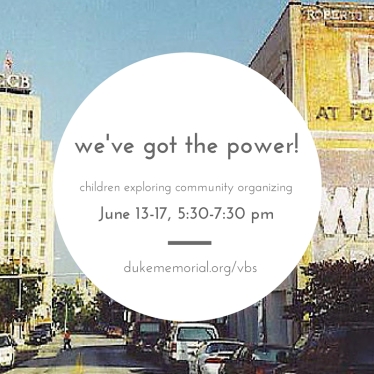
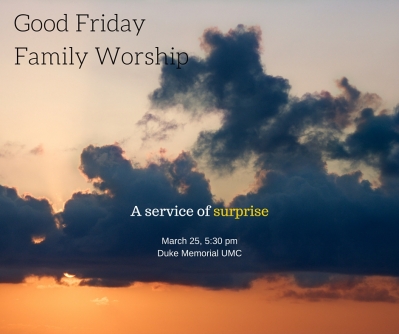


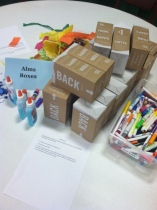 On Sunday we prepared ourselves for the coming of Lent with our Lent Workshop, a cross-generational Sunday school hour with hands-on projects to get us ready to practice Lent in the home.
On Sunday we prepared ourselves for the coming of Lent with our Lent Workshop, a cross-generational Sunday school hour with hands-on projects to get us ready to practice Lent in the home.
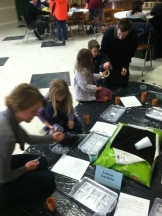 alms box, a place to hold your loose change. At the end of Lent bring these back to church and they will be donated to our Good Samaritan Fund to help under-resourced families in our community. Lent is a time of giving.
alms box, a place to hold your loose change. At the end of Lent bring these back to church and they will be donated to our Good Samaritan Fund to help under-resourced families in our community. Lent is a time of giving.


